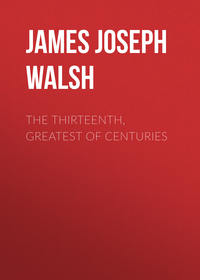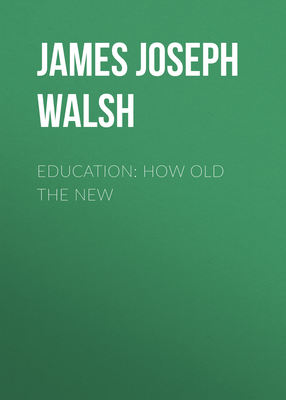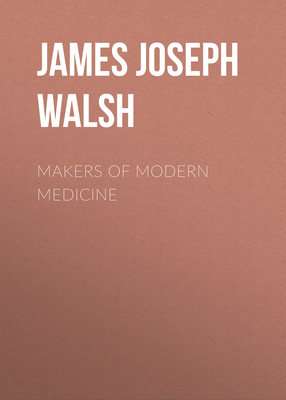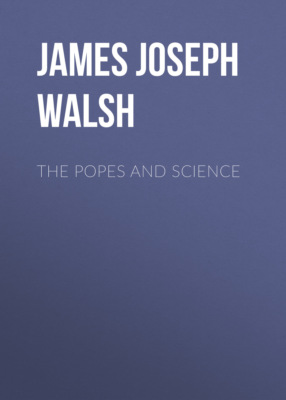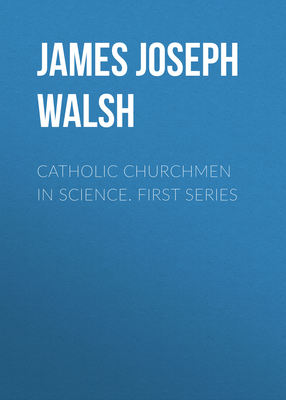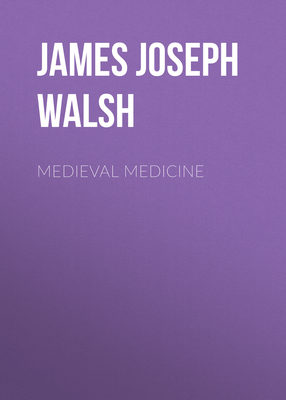Kitabı oku: «The Thirteenth, Greatest of Centuries», sayfa 34
V. INSURANCE
Insurance is usually supposed to be a modern idea representing one of those developments of the capitalization of mutual risks of life, property, and the like that have come as a consequence of modern progress. The insurance system of the Middle Ages, the organization of which came in the Thirteenth Century, is therefore extremely interesting. It was accomplished, as was every form of co-operation and co-ordination of effort, through special gilds or through the trade or merchant gilds. Among the objects of the gilds enumerated by Toulmin Smith is insurance against loss by fire. This was paid through the particular gild to which the merchant belonged, or in the case of the artisan through a special gild which he joined for the purpose. Provision was made, however, for much more than insurance by fire. Our fire insurance companies are probably several centuries old, so also are our insurance arrangements against shipwreck. Other features of insurance, however, are much more recent. Practically all of these were in active existence during the Middle Ages, though they disappeared with the so-called reformation, and then did not come into existence again for several centuries and, indeed, not until our own time.
The old gilds, for instance, provided insurance against loss from flood, a feature of insurance that has not, so far as I know, developed in our time, against loss by robbery (our burglary insurance is quite recent), against loss by the fall of a house, by imprisonment, and then also insurance against the loss of cattle and farm products. All the features of life insurance also were in existence. The partial disability clauses of life or accident insurance policies are recent developments. In the old days there is insurance against the loss of sight, against the loss of a limb, or any other form of crippling. The deaf and dumb might be insured so as to secure an income for them, and corresponding relief for leprosy might be obtained; so that, if one were set apart from the community by the law requiring segregation of lepers, there might be provision for food and lodging, even though productive work had become impossible. In a word, the insurance system of the Middle Ages was thoroughly developed. It was not capitalistic. The charges were only enough to maintain the system, and not such as to provide large percentage returns on invested stock and on bonds, and the accumulation of huge surpluses that almost inevitably lead to gross abuses. What is best in our modern system of insurance is an imitation of the older methods. Certain of the trade insurance companies which assume a portion of the risk on mills, factories and the like, are typical examples. They know the conditions, enforce proper precautions, keep an absolute check on suspicious losses, accumulate only a moderate surplus and present very few opportunities for insurance abuses. The same thing is true for the fraternal societies that conduct life insurance. When properly managed they represent the lowest possible cost and the best efficiency with least opportunities for fraud and without any temptations to interfere with legislation and any allurements for legislators to spend their time making strike and graft bills instead of doing legislative work.
VI. OLD AGE PENSIONS
This generation has occupied itself much with the question of old age pensions. Probably most people feel that this is the first time in the world's history that such arrangements have been made. The movement is supposed to represent a recent development of humanitarian purpose, and to be a feature of recent philanthropic evolution. It is rather interesting, in the light of that idea, to see how well they accomplish this same purpose in the Thirteenth and Fourteenth Centuries. In our time it has been a government affair, with all the possibilities of abuse that there are in a huge pension system, and surely no country knows it better than we do here in America. The old countries, Germany and France, have established a contributing system of pension. This was the model of their system of caring for the old and the disabled in the Middle Ages. Toulmin Smith cites a rule of one of the gilds which gives us exactly the status of the old age disability pension question. After a workman had been seven years a member, the gild assured him a livelihood in case of disability from any cause.
When we recall that employer as well as employee as a rule belonged to the gild and this was a real mutual organization in which there was a sharing of the various risks of life, we see how eminently well adapted to avoid abuses this old system was. Where the pensioners appeal to a government pension system, abuses are almost inevitable. There is the constant temptation to exploit the system on the part of the pensioners, because they have the feeling that if they do not, others will. Then the investigation of each particular case is difficult, and favoritism and graft of various kinds inevitably finds its way in. Where the pension is paid by a small body of fellow workmen, the investigation is easy, the temptation to exploit does not readily find place, and while abuses are to some extent inevitable, these are small in amount, and not likely to be frequent. Friends and neighbors know conditions, and men are not pauperized by the system, and if, after an injury that seemed at first so disabling as to be permanent, the pensioner should improve enough to be able to get back to work, or, at least, to do something to support himself, the system is elastic enough so that he is not likely to be tempted to continue to live on others rather than on his own efforts.
VII. THE WAYS AND MEANS OF CHARITY—ORGANIZED CHARITY
Most of us would be apt to think that our modern methods of obtaining funds for charitable purposes represented definite developments, and that at least special features of our collections for charity were our own invention. In recent years the value of being able to reach a great many people even for small amounts has been particularly recognized. "Tag day" is one manifestation of that. Everyone in a neighborhood is asked to contribute a small amount for a particular charitable purpose, and the whole collection usually runs up to a snug sum. Practices very similar to this were quite common in the Thirteenth Century. As in our time, it was the women who collected the money. A rope, for instance, was stretched across a marketplace, where traffic was busy, and everyone who passed was required to pay a toll for charity. Occasionally the rope was stretched across a bridge and the tolls were collected on a particular day each year. Other forms of charitable accumulation resembled ours in many respects. Entertainments of various kinds were given for charity, and special collections were made during the exhibition of mystery plays partly to pay the expenses of the representation, and the surplus to go to the charities of the particular gild.
Most of the charity, however, was organized. Indeed it is the organization of charity during the Thirteenth Century that represents the best feature of its fraternalism. The needy were cared for by the gilds themselves. There were practically no poorhouses, and if a man was willing to work and had already shown this willingness, there were definite bureaus that would help him at least to feed his family while he was out of work. This system, however, was flexible enough to provide also for the ne'er-do-wells, the tramps, the beggars, but they were given not money, but tokens which enabled them to obtain the necessaries of life without being able to abuse charity. The committees of the gilds consulted in various ways among themselves and with the church wardens so as to be sure that, while all the needy were receiving help, no one was abusing charity by drawing help from a number of different quarters. Of course, they did not have the problem of large city life that we have, and so their comparatively simple organization of charity sufficed for all the needs of the time, and at the same time anticipated our methods.
VIII. SCIENTIFIC UNIVERSITIES
In the first edition of this book I called attention to the fact, that science, even in our sense of physical science, was, in spite of impressions to the contrary, a favorite subject for students and teachers in the early universities. What might have been insisted on, however, is that these old universities were scientific universities resembling our own so closely in their devotion to science as to differ from them only in certain unimportant aspects. Because the universities for three centuries before the Nineteenth had been occupied mainly with classical studies, we are prone to think that these were the main subjects of university teaching for all the centuries before. Nothing could well be less true. The undergraduate studies consisted of the seven liberal arts so-called, though these were largely studied from the scientific standpoint. The quotation from Prof. Huxley ( Appendix III., Education) makes this very clear. What we would now call the graduate studies consisted of metaphysics, in which considerable physics were studied, astronomy, medicine, above all, mathematics, and then the ethical sciences, under which were studied what we now call ethics, politics and economics. The picture of these medieval universities as I have given them in my lecture on Medieval Scientific Universities, in "Education, How Old the New," makes this very clear. The interests and studies were very like those of our own time, only the names for them being different. Nature-study was a favorite subject, and, as I have pointed out in "The Popes and Science," Dante must be considered as a great nature student, for he was able to draw the most exquisite figures from details of knowledge of living things with which few poets are familiar. The books of the professors of the Thirteenth Century which have been preserved, those of Albertus Magnus, Roger Bacon, Aquinas, Duns Scotus and others, make it very clear that scientific teaching was the main occupation of the university faculties, while the preservation of these huge tomes by the diligent copying of disciples shows how deeply interested were their pupils in the science of the time.
IX. MEDICAL TEACHING AND PROFESSIONAL STANDARDS
At all times in the history of education, the standards of scientific education, and the institutions of learning, can be best judged from the condition of the medical schools. When the medical sciences are taken seriously, when thorough preparation is demanded before their study may be taken up, when four or five years of attention to theoretic and practical medicine are required for graduation, and when the professors are writing textbooks that are to attract attention for generations afterwards, then, there is always a thoroughly scientific temper m the university itself. Medicine is likely to suffer, first, whenever there is neglect of science. The studies of the German historians, Puschmann, Pagel, Neuberger, and Sudhoff in recent years, have made it very clear that the medical schools of the universities of the Thirteenth Century were maintaining high standards. The republication of old texts, especially in France, has called attention to the magnificent publications of their professors, while a review of their laws and regulations confirms the idea of the good work that was being done. Gurlt, in his history of surgery, "Geschichte der Chirurgie" (Berlin, 1898), has reviewed the textbooks of Roger and Roland and the Four Masters, of William of Salicet and Lanfranc and of many others, in a way to make it very clear that these men were excellent teachers.
When we discover that three years of preparatory university work was required before the study of medicine could be begun, and four years of medical studies were required, with a subsequent year of practice under a physician's direction, before a license for independent practice could be issued, then the scientific character of the medical schools and therefore of the universities to which they were attached is placed beyond all doubt. These are the terms of the law issued by the Emperor Frederick II. for the Two Sicilies. That, in substance, it applied to other countries we learn from the fact that the charters of medical schools granted by the Popes at this time require proper university preliminary studies, and four or five years at medicine before the degree of Doctor could be given. We know besides that in the cities only those who were graduates of properly recognized medical schools were allowed to practice medicine, so that there was every encouragement for the maintenance of professional standards. Indeed, strange as it may seem to our generation, the standards of the Thirteenth Century in medical education were much higher than our own, and their medical schools were doing fine work.
X. MAGNETISM
For proper understanding of the Thirteenth Century scholars, it is especially important to appreciate their thoroughly scientific temper of mind, their powers of observation, and their successful attainments in science. I know no more compendious way of reaching the knowledge of these qualities in the medieval mind, than a study of the letter of Peregrinus, which we would in our time call a monograph on magnetism. Brother Potamian, in his chapter in "Makers of Electricity" (Fordham University Press, N. Y., 1909) on Peregrinus and Columbus, sums up the very interesting contributions of this medieval student of magnetism to the subject. The list of chapters alone in Peregrinus' monograph (Epistola) makes it very clear how deep were his interests and how thoroughly practical his investigations.

THE DOUBLE PIVOTED NEEDLE OF PEREGRINUS.
They are:—"Part I., Chapter i, purpose of this work; 2, qualifications of the experimenter; 3, characteristics of a good lodestone; 4, how to distinguish the poles of a lodestone; 5, how to tell which pole is north and which is south; 6, how one lodestone attracts another; 7, how iron touched by a lodestone turns toward the poles of the world; 8, how a lodestone attracts iron; 9, why the north pole of one lodestone attracts the south pole of another, and vice versa; 10, an inquiry into the natural virtue of the lodestone.
"Part II., Chapter 1, construction of an instrument for measuring the azimuth of the sun, the moon or any star then in the horizon; 2, construction of a better instrument for the same purpose; 3, the art of making a wheel of perpetual motion."
In order to illustrate what Peregrinus accomplished it has seemed worth while to reproduce here the sketches which illustrate his epistle. We have the double pivoted needle and the first pivoted compass.
In the light of certain recent events a passage from the "New Naval History or Complete Review of the British Marine" (London, 1757) is of special interest. It illustrates perhaps the new confidence that came to men in sailing to long distances as the result of the realization of the practical value of the magnetic needle during the Thirteenth Century.

FIRST PIVOTED COMPASS (PEREGRINUS, 1269).
"In the year 1360 it is recorded that a friar of Oxford called Nicholas de Linna (of Lynn), being a good astronomer, went in company with others to the most northern island, and thence traveled alone, and that he went to the North Pole, by means of his skill in magic, or the black art; but this magic or black art may probably have been nothing more than a knowledge of the magnetic needle or compass, found out about sixty years before, though not in common use until many years after."
XI. BIOLOGICAL THEORIES, EVOLUTION, RECAPITULATION
Of course only those who are quite unfamiliar with the history of philosophic thought are apt to think that the theory of evolution is modern. Serious students of biology are familiar with the long history of the theory, and especially its anticipations by the Greeks. Very few know, however, that certain phases of evolutionary theory attracted not a little attention from the scholastic philosophers. It would not be difficult to find expressions in Roger Bacon and Albertus Magnus, that would serve to show that they thought not only of the possibility of some very intimate relation of species but of developmental connections. The great teacher of the time, St. Thomas Aquinas, has some striking expressions in the matter, which deserve to be quoted, because he is the most important representative of the philosophy and science of the century and the one whose works most influenced succeeding generations. In the lecture on Medieval Scientific Universities, published in "Education, How Old the New" (Fordham University Press, N. Y., 1910), I called particular attention to this phase of St. Thomas' teaching. Two quotations will serve to make it clear here.
Prof. Osborne, in "From the Greeks to Darwin," quotes Aquinas' commentary on St. Augustine's opinion with regard to the origin of things as they are. Augustine declared that the Creator had simply brought into life the seeds of things, and given these the power to develop. Aquinas, expounding Augustine, says:
"As to production of plants, Augustine holds a different view, … for some say that on the third day plants were actually produced, each in his kind—a view favored by the superficial reading of Scripture. But Augustine says that the earth is then said to have brought forth grass and trees causaliter; that is, it then received power to produce them." (Quoting Genesis ii:4): "For in those first days, … God made creation primarily or causaliter, and then rested from His work."
Like expressions might be quoted from him, and other writers of the Thirteenth Century might well be cited in confirmation of the fact that while these great teachers of the Middle Ages thoroughly recognize the necessity for creation to begin with and the placing by the Creator of some power in living things that enables them to develop, they were by no means bound to the thought that all living species were due to special creations. They even did not hesitate to teach the possibility of the lower order of living beings at least coming into existence by spontaneous generation, and would probably have found no difficulty in accepting a theory of descent with the limitations that most scientific men of our generation are prone to demand for it.
Lest it should be thought that this is a mere accidental agreement with modern thought, due much more to a certain looseness of terms than to actual similarity of view, it seems well to point out how close St. Thomas came to that thought in modern biology, which is probably considered to be one of our distinct modern contributions to the theory of evolution, though, in recent years, serious doubts have been thrown on it. It is expressed by the formula of Herbert Spencer, "Ontogeny recapitulates phylogeny." According to this, the completed being repeats in the course of its development the history of the race, that is to say, the varying phases of foetal development from the single cell in which it originates up to the perfect being of the special type as it is born into the world, retrace the history by which from the single cell being the creature in question has gradually developed.
It is very curious to find that St. Thomas Aquinas, in his teaching with regard to the origin and development of the human being, says, almost exactly, what the most ardent supporters of this so-called fundamental biogenetic law proclaimed during the latter half of the Nineteenth Century, thinking they were expressing an absolutely new thought. He says that "the higher a form is in the scale of being and the farther it is removed from mere material form, the more intermediate forms must be passed through before the finally perfect form is reached. Therefore, in the generation of animal and man— these having the most perfect forms—there occur many intermediate forms in generations, and consequently destruction, because the generation of one being is the destruction of another." St. Thomas draws the ultimate conclusions from this doctrine without hesitation. He proclaims that the human material is first animated by a vegetative soul or principle of life, and then by an animal soul, and only ultimately when the matter has been properly prepared for it by a rational soul. He said: "The vegetative soul, therefore, which is first in embryo, while it lives the life of a plant, is destroyed, and there succeeds a more perfect soul, which is at once nutrient and sentient, and for that time the embryo lives the life of an animal: upon the destruction of this there succeeds the rational soul, infused from without."
